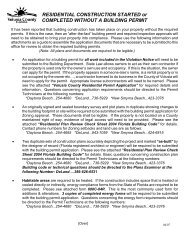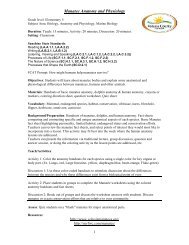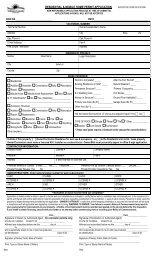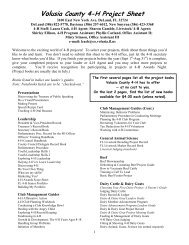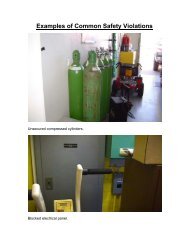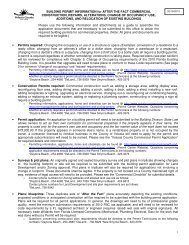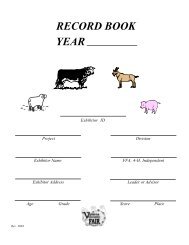Local mitigation strategy (LMS) - Volusia County Government
Local mitigation strategy (LMS) - Volusia County Government
Local mitigation strategy (LMS) - Volusia County Government
Create successful ePaper yourself
Turn your PDF publications into a flip-book with our unique Google optimized e-Paper software.
SECTION 6: VULNERABILITY ASSESSMENTlevel (e.g., county or city). Jurisdictional level population estimates cannot be used to accurately conductGIS analyses to determine how much of the population is exposed to various hazards based ongeographic location (i.e., census block or tract level). The next decennial census population data will beavailable in April 2011, at which time the county will consider reassessing the populations that arevulnerable to various hazards.The objective of the GIS-based analysis was to determine the estimated vulnerability of people, buildingsand critical facilities to the identified hazards for <strong>Volusia</strong> <strong>County</strong> using best available geospatial data. In sodoing, local databases made available through <strong>Volusia</strong> <strong>County</strong> such as local tax assessor records, parcelboundaries and critical facilities data, were used in combination with digital hazard data. The results ofthe analysis provided an estimated number of people, as well as the numbers and values of buildings andcritical facilities determined to be potentially at risk to those hazards with delineable geographic hazardboundaries. These hazards included flood, storm surge, dam failure, wildfire and technological hazards. Amore specific description of the GIS-based analysis for each particular hazard is provided under thevulnerability assessment section of each respective hazard.MEMPHISMapping for Emergency Management, Parallel Hazard Information System (MEMPHIS) was used in thisassessment for <strong>Volusia</strong> <strong>County</strong>. MEMPHIS was accessed to obtain hazards shapefile data for coastalerosion, tsunami, sinkhole and wildfire to determine property and critical facility exposure and lossestimates 1 . For more information about MEMPHIS, please visit http://lmsmaps.kinanco.com/.HAZUS-MHHAZUS-MH is FEMA’s standardized loss estimationsoftware program built upon an integrated GIS platform(Figure 6.1) to conduct analysis at a regional level (i.e.,not on a structure-by-structure basis). The HAZUS-MH riskassessment methodology is parametric, in that distincthazard and inventory parameters (e.g., wind speed andbuilding types) were modeled using the HAZUS-MHsoftware to determine the impact (i.e., damages andlosses) on the built environment. This risk assessmentapplied HAZUS-MH to produce countywide profiles andestimate losses for three hazards at the jurisdictionallevel. At the time this analysis was completed, HAZUS-MH MR-3 (September 2007) was used to estimatepotential losses from hurricane winds, coastal flood, and earthquake using HAZUS-MH default buildingstock inventory data. The results of the HAZUS-MH model analysis include annualized loss estimates foreach participating jurisdiction in <strong>Volusia</strong> <strong>County</strong> so that potential loss values may be compared to oneanother throughout <strong>Volusia</strong> <strong>County</strong>. In generating loss estimates through HAZUS-MH, some datanormalization was necessary to account for recognized differences between actual assessed buildingvalues as provided by <strong>Volusia</strong> <strong>County</strong> and estimated replacement building value data as provided withinHAZUS-MH. In order to account for the difference between modeled and actual values, the ratio of1 MEMPHIS was created by Kinetic Analysis Corporation under contract with the Florida Department of Community Affairs in support of theFlorida <strong>Local</strong> Mitigation Strategy Project. For more information about MEMPHIS, please visit http://lmsmaps.kinanco.com/.<strong>Volusia</strong> <strong>County</strong> Multi-jurisdictional <strong>Local</strong> Mitigation StrategyFebruary 20106:3




